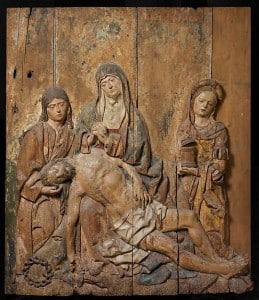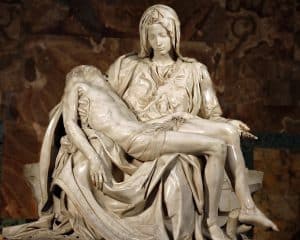
Guest Post by Exponent II Board Member, Margaret Moore
Last year at the Exponent retreat a women’s chorus performed Stephen Hatfield’s When it was Yet Dark during the Sabbath meeting. It is a contemporary Easter anthem set to the simple yet beautiful hymn tune Pleading Savior. The title of the work comes from the Gospel of John 20:1, and the text begins by following the narrative outlined in the scriptures but from Mary Magdalene’s perspective. To me the text, written by the composer, is an astonishing feminist anthem for Christian women. I find the mixture of the poetry and music deeply moving, comforting and empowering every time I hear or perform this work.
The piece begins simply with unison singing, adding voice parts and harmony at each couplet:
“Then when Mary Magdelena,
Came to the tomb to anoint the dead.
There in the mist of the Easter morning,
She found empty stone instead.
Where were the soldiers to guard the body?
Where was the click of the dice at play?
Where was the smell of death and dying?
How was the great stone rolled away?”
And builds to forte singing as Mary contemplates what has happened to the Lord’s body:
“What does it mean and how could it happen?
Who would defile a poor man’s grave?
Where was the teacher who taught
that even women like me were fit to save?”
The phrase “women like me were fit to save” reminds me that Jesus loved and accepted a “sinner” like Mary, and also that he also showed deep love, friendship, affection, and mercy as He interacted with the few women mentioned in the New Testament. This statement also emboldens me to claim and know for myself that as a woman, I am enough on my own to be redeemed by the Savior.
Then the Lord appears, asking her:
“Woman, tell me why you’re weeping?
Why on a morn so fresh and fair?”
“I came to pray for my Lord, but look,
the grave has been robbed and his tomb lies bare.
(He’s not there.)
“Can’t you tell me where he’s been taken, I’ll do anything you say
Where was the man who had called me Mary
when all of the others had turned away?”
This next holy moment is sung slowly and quietly:
“Then he spoke to Magdelena
she heard her name so soft and low.
Then she knew he had died to teach her
what there was no other way to know.”
What did Jesus die to teach us? I’m reminded of a beautiful sermon I heard last Easter given by the Reverend Samuel T. Lloyd, III of Trinity Church, Boston. He said that Christ’s resurrection revealed a power stronger than death, which sets us free to live without fear. That in Jesus we find strength and hope when we couldn’t imagine a future. When we love and serve like Jesus, our actions become living proof that Christ was raised from the tomb; when we spread His news that all people deserve love and honor, He lives.
Since November, I have had a hard time imagining my future as a member of the church. This poetry and music centers me on the loving teachings of Jesus Christ, which transcend denomination and creed. These powerful teachings are echoed in the next four lines, which are sung forte by the choir:
“(I know)
Shame and pain can never defeat you,
Spirit is fire and flesh it is clay.
Back to the clay go the men who mock you,
Death is a great stone rolled away.”
Jesus’ life and death teach us that there is a power that cannot be conquered by shame, pain or loss. Our spirits of fire will go on as our earthly flesh falls away. The pain of this world will end; death was made into nothing but a great stone by the resurrection of the Lord.
As a feminist, I also hear Christ reminding me that the marginalization of women in the church will go “back to the clay.” His power and love are greater than our earthy errors and judgments.
The final stanza from the piece is an invocation of a holy trinity of women in Christian history: the mother of Jesus, the friend of Jesus, and the first apostle of Jesus’ resurrection:
One was Mary bearing the baby;
Two was Mary whose brother was reborn.
Three, was Mary Magdalena
Bearing the gospel on Easter morn.
This declaration is punctuated by a rest after the word “one,” which creates a moment of rhythmic tension in the music that is thrilling. Proclaiming this trinity reminds me that women are powerfully present in the life of the Lord. When I remember that truth, I feel both affirmation and comfort. I hope you find joy in Stephen Hatfield’s When it was Yet Dark as I do.







4 Responses
I loved this so much at the retreat last year! I’m delighted to have access to it now all. year. long. Thank you for your poignant and heartfelt explanation of why it means even more to you post-policy, Margaret.
Thanks for your reflections. I love the idea of the three Marys being a holy trinity of women. I’ve sung this piece as a trio in sacrament meeting, and it’s lovely. Thanks for bringing it back to mind.
I can’t thank you enough for this beautiful post. I hadn’t heard of this song before. I’ve been discouraged lately and your words are a salve to my heart. I’m so grateful to have read your post today.
[…] Sacred Music […]